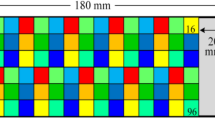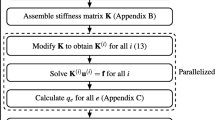Abstract
This paper proposes an efficient fail-safe approach considering fatigue. The method extends classical fail-safe optimization to the fatigue field in the framework of the solid isotropic material with penalization (SIMP) method. The material properties of the failure model are interpolated by using the equivalent fatigue von Mises stress. The worst-case compliance is considered to minimize as the optimization objective, using the Kreisselmeier–Steinhauser (KS) function to approximate the non-differentiable max-operator. The fatigue sensitivity is derived by the adjoint method, and a general fail-safe optimality criteria (FS-OC) method is developed to update design variables. Finally, the effectiveness of this method for fail-safe optimization is verified by several numerical examples with acceptable computational efficiency.














Similar content being viewed by others
References
Allaire G, Jouve F, Toader AM (2004) Structural optimization using sensitivity analysis and a level-set method. J Comput Phys 194:363–393
Ambrozkiewicz O, Kriegesmann B (2018) Adaptive Strategies for Fail-Safe Topology Optimization. In: EngOpt 2018 Proceedings of the 6th International Conference on Engineering Optimization. Springer, pp 200–211
Ambrozkiewicz O, Kriegesmann B (2020) Density-based shape optimization for fail-safe design. J Comput Des Eng 7:615–629
Arora JS, Haskell DF, Govil AK (1980) Optimal design of large structures for damage tolerance. Zoosyst Evol 18:563–570
Bendsøe MP, Kikuchi N (1988) Generating optimal topologies in structural design using a homogenization method. Comput Methods Appl Mech Eng 72:197–224
Bendsøe MP (1989) Optimal shape design as a material distribution problem. Struct Optim 1:193–202
Bendsøe MP, Díaz AR (1998) A method for treating damage related criteria in optimal topology design of continuum structures. Struct Optim 16:108–115
Bourdin B (2001) Filters in topology optimization. Int J Numer Methods Eng 50:2143–2158
Bruggi M (2008) On an alternative approach to stress constraints relaxation in topology optimization. Struct Multidisc Optim 36:125–141
Bruns TE, Tortorelli DA (2001) Topology optimization of non-linear elastic structures and compliant mechanisms. Comput Methods Appl Mech Eng 190:3443–3459
Collet M, Bruggi M, Duysinx P (2017) Topology optimization for minimum weight with compliance and simplified nominal stress constraints for fatigue resistance. Struct Multidisc Optim 55:839–855
Feng Y, Moses F (1986) Optimum design, redundancy and reliability of structural systems. Comput Struct 24:239–251
Guest JK, Prévost JH, Belytschko T (2004) Achieving minimum length scale in topology optimization using nodal design variables and projection functions. Int J Numer Methods Eng 61:238–254
Guo X, Zhang WS, Zhong WL (2014) Doing topology optimization explicitly and geometrically—a new moving morphable components based framework. J Appl Mech 81:081009
Holmberg E, Torstenfelt B, Klarbring A (2014) Fatigue constrained topology optimization. Struct Multidisc Optim 50:207–219
Huang X, Xie YM (2007) Convergent and mesh-independent solutions for the bi-directional evolutionary structural optimization method. Finite Elem Anal Des 43:1039–1049
Jansen M, Lombaert G, Schevenels M, Sigmund O (2014) Topology optimization of fail-safe structures using a simplified local damage model. Struct Multidisc Optim 49:657–666
Jeong SH, Choi DH, Yoon GH (2014) Fatigue and static failure considerations using a topology optimization method. Appl Math Modell 39:1137–1162
Kranz M, Lüdeker JK, Kriegesmann B (2021) An empirical study on stress-based fail-safe topology optimization and multiple load path design. Struct Multidisc Optim 64:2113–2134
Lee HA, Park GJ (2012) Topology optimization for structures with nonlinear behavior using the equivalent static loads method. J Mech Des 134:031004
Marhadi KS, Venkataraman S, Wong SA (2011) Load redistribution mechanism in damage tolerant and redundant truss structure. Struct Multidisc Optim 44:213–233
Michell AGM (1904) The limits of economy of material in frame-structures. Lond Edinb Dublin Philos Mag J Sci 8:589–597
Nabaki K, Shen JH, Huang X (2019) Evolutionary topology optimization of continuum structures considering fatigue failure. Mater Des 166:107586
Osher S, Sethian JA (1988) Fronts propagating with curvature-dependent speed: algorithms based on Hamilton-Jacobi formulations. J Comput Phys 79:12–49
Park GJ, Lee Y (2018) Discussion on the optimality condition of the equivalent static loads method for linear dynamic response structural optimization. Struct Multidisc Optim 59:311–316
Rozvany GIN (2008) A critical review of established methods of structural topology optimization. Struct Multidisc Optim 37:217–237
Sethian JA, Wiegmann A (2000) Structural boundary design via level set and immersed interface methods. J Comput Phys 163:489–528
Sigmund O (1994) Materials with prescribed constitutive parameters: an inverse homogenization problem. Int J Solids Struct 31:2313–2329
Sigmund O (2001) A 99 line topology optimization code written in Matlab. Struct Multidisc Optim 21:120–127
Sun PF, Arora JS, Haug EJ (1976) Fail-safe optimal design of structures. Eng Optim 2:43–53
Verbart A, Langelaar M, Keulen FV (2016) Damage approach: a new method for topology optimization with local stress constraints. Struct Multidisc Optim 53:1081–1098
Wang HX, Liu J, Wen GL, Xie YM (2020) The robust fail-safe topological designs based on the von Mises stress. Finite Elem Anal Des 171:103376
Wang HX, Liu J, Wen GL (2022) A study on fail-safe topological design of continuum structures with stress concentration alleviation. Struct Multidisc Optim 65:174
Wei P, Wang MY, Xing X (2010) A study on X-FEM in continuum structural optimization using a level set model. Comput-Aided Des 42:708–719
Xie YM, Steven GP (1993) A simple evolutionary procedure for structural optimization. Comput Struct 49:885–896
Xu XK, Guo BF, Jin M (2017) A new bilateral density filter with cross template for structural topology optimization. J Mech Eng Sci 232:3823–3832
Yang XY, Xie YM, Steven GP, Querin OM (1999) Bidirectional evolutionary method for stiffness optimization. AIAA J 37:1483–1488
Zhang WS, Yuan J, Zhang J, Guo X (2015) A new topology optimization approach based on Moving Morphable Components (MMC) and the ersatz material model. Struct Multidisc Optim 53:1243–1260
Zhou M, Fleury R (2016) Fail-safe topology optimization. Struct Multidisc Optim 54:1225–1243
Zhou M, Sigmund O (2021) Complementary lecture notes for teaching the 99/88-line topology optimization codes. Struct Multidisc Optim 64:3227–3231
Zuo WJ, Saitou K (2016) Multi-material topology optimization using ordered SIMP interpolation. Struct Multidisc Optim 55:477–491
Acknowledgements
This work was supported by the National Natural Science Foundation of China (No. 11217020530) and the National Key Research and Development Program of China (No. 2020YFA0713604). The authors thank the anonymous reviewers for their helpful comments and suggestions.
Author information
Authors and Affiliations
Corresponding author
Ethics declarations
Conflict of interest
The authors declare that they have no conflict of interest.
Replication of results
The author states that the paper contains all information necessary to reproduce the results.
Additional information
Responsible Editor: Shikui Chen
Publisher's Note
Springer Nature remains neutral with regard to jurisdictional claims in published maps and institutional affiliations.
Rights and permissions
Springer Nature or its licensor (e.g. a society or other partner) holds exclusive rights to this article under a publishing agreement with the author(s) or other rightsholder(s); author self-archiving of the accepted manuscript version of this article is solely governed by the terms of such publishing agreement and applicable law.
About this article
Cite this article
Zhao, T., Zhang, Y., Ou, Y. et al. Fail-safe topology optimization considering fatigue. Struct Multidisc Optim 66, 132 (2023). https://doi.org/10.1007/s00158-023-03588-8
Received:
Revised:
Accepted:
Published:
DOI: https://doi.org/10.1007/s00158-023-03588-8




